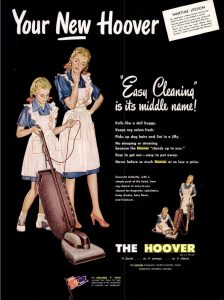
The piece I have chosen to subvert is a 1945 advertisement for the Hoover vacuum, taken from Life magazine This advertisement provides an underlying message based on the intersections of gender, race, social class, and age (Crenshaw). Firstly, race plays a component in this ad because the women are white and portray the domesticity of white women during this time. While women of color were already taking part in the workforce, white women often struggled to establish themselves in the public and were most often seen as solely homemakers. Next, social class is also a large factor in this ad. This ad promotes that being a good wife is someone who keeps the house clean and therefore is able to afford a nice vacuum. To afford a nice vacuum, women would then need to rely on their husbands for monetary support and perpetuate the male breadwinner ideal. The last component is age and socialization. In this advertisement, we see what looks like a mother teaching her daughter how to clean and take care of the house. This shows the socialization of a young girl into female gender roles by enforcing the idea that cleaning the house is her role in society and that she must be prepared to do this in the future. Along the lines of gender roles, I also wanted to draw attention to the text at the bottom. It discusses the “E” rating Army-Navy award that the Hoover company has received for helping with the production of essential war equipment. This may be seen as promoting the idea that Hoover vacuums are considered essential war equipment because women were expected to stay home and clean in order to let their husbands go off to war.

In order to bring out the underlying assumptions of the advertisement, I have made three changes to the various texts. I have decided not to change the images because I believe that they are important to the overall message and show the intersectionality of race, gender, social class, and age that the advertisement consists of. I’ve changed the main text to read “White, middle-upper class women should buy this vacuum so that they can stay home and clean!!”. I did this because I believe that this is the main message of the advertisement and the main impression it aims to leave on viewers. I also made sure this text was prominent and in large text for this same reason. In addition, I changed the text under this to point out the obvious gender socialization which this advertisement promotes with the mother teaching the daughter how to vacuum. At the bottom, I’ve changed the “E” rating from the US Army-Navy to say “The US Army encourages gender roles”. I did this because by giving a vacuum company an award for helping with wartime equipment production, the Army is reinforcing the idea that women need to stay home and do housework in order for men to take part in the army. I believe that these changes make viewers see the true implications of the advertisement. What may seem to be a simple vacuum cleaner ad is actually a stereotype-promoting advertisement.